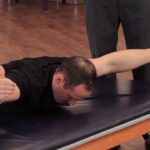Prone Scapula Raises | Early Intervention Ergonomics
What are the Prone Scapula Raises?
The prone scapula raise exercise is a movement that primarily targets the muscles of the upper back and shoulder region. It helps improve scapular stability, posture, and strength in the muscles responsible for retracting and depressing the scapulae (shoulder blades).
Here’s how you can perform the prone scapula raise exercise:
- Lie face down on a flat surface, such as an exercise mat or bench.
- Extend your arms straight out in front of you, hold thumbs up like Fonzie pointed towards the ceiling. Hold this for two or three seconds and back down from that position.
- Next, bring your arms out a little bit wider, more into a “Y” position again making sure that your thumbs are rotating up towards the ceiling while lifting your arms off the mat or bench. Now bring the arms back down.
- Now bring your arms down straight out to the side, and as you lift your arms up, rotate the thumbs up again towards the ceiling. Keep that chin tucked so you’re not leading with your head.
- Finally, bring your hands together into a “W” position, lifting up the thumbs again pointed towards the ceiling. Then back down all the way to our side and what we’re going to do is lift our hands up, rotate thumbs up as we’re lifting the head, the chest and the shoulders up off of the mat or bench and then relax.
- This sequence typically is repeated 3-4 times with one or two repetitions each.
It’s important to note that the prone scapula raise exercise primarily targets the muscles responsible for scapular retraction and depression rather than the muscles involved in arm
Early Intervention Benefits of this Exercise
The prone scapula raise exercise offers several benefits for the muscles and structures involved in scapular stability and posture. Here are some of the key early intervention benefits:
- Scapular Stability: The exercise targets the muscles that retract and depress the scapulae, such as the rhomboids, middle trapezius, and lower trapezius. By strengthening these muscles, it improves scapular stability, which is crucial for proper shoulder mechanics and overall upper body function.
- Posture Improvement: Weakness or imbalance in the muscles around the scapulae can contribute to poor posture, including rounded shoulders and forward head posture. The prone scapula raise exercise helps correct these postural imbalances by strengthening the muscles responsible for scapular retraction, promoting a more upright and aligned posture.
- Shoulder Health: Proper scapular function is essential for healthy shoulder movement. By strengthening the muscles that stabilize and control scapular motion, the exercise can reduce the risk of shoulder injuries, impingements, and overuse syndromes.
- Upper Back Strength: The prone scapula raise exercise engages the muscles of the upper back, including the rhomboids, middle trapezius, and lower trapezius. By targeting these muscles, it improves upper back strength, which is important for daily work activities, and overall functional fitness.
- Rehabilitation: The exercise is often prescribed as part of rehabilitation programs for various shoulder and upper back conditions, such as shoulder impingement syndrome, rotator cuff injuries, and postural abnormalities. It helps retrain and strengthen the muscles involved in scapular stability and control, aiding in the recovery process.
- Body Awareness: Performing the prone scapula raise exercise requires mindful control of scapular movement and muscle activation. Over time, it enhances body awareness and proprioception, allowing individuals to better understand and control their shoulder and upper back positioning in various movements and activities.
Things to Remember…
Remember, consistency and proper form are essential for reaping the benefits of any exercise. If you have specific concerns or conditions, it’s always advisable to consult with a qualified healthcare or fitness professional who can provide personalized guidance tailored to your needs.
This early intervention exercise is used to improve overall health and fitness as well as help reduce work-related injuries. If you have an injury or illness, consult with a health care professional before attempting.
More Tools & Resources from Peak Ergonomics
Contact Us About Reducing Workplace Injuries
Healthy Employees are the Bottom Line! – Learn More!

